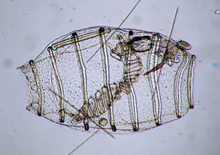Thaliacea
| Thaliacea | |
|---|---|

| |
| Pyrosoma atlanticum, a pyrosome | |

| |
doliolid
| |
| Scientific classification | |
| Domain: | Eukaryota |
| Kingdom: | Animalia |
| Phylum: | Chordata |
| Subphylum: | Tunicata |
| Class: | Thaliacea Nielsen, 1995 |
| Orders | |
| |
Thaliacea is a class of marine animals within the subphylum
Anatomy
The three orders of thaliaceans are
Doliolids and salps alternate between asexual and sexual life stages. Salp colonies can be several meters in length. Doliolids and salps rely on muscular action to propel themselves through surrounding seawater.
Thaliaceans have complex lifecycles. Doliolid eggs hatch into swimming tadpole larvae, which are the common larval stage for other
The dorsal, hollow nerve cord and notochord found in Chordata has been lost, except for a rudimentary one in some doliolid larvae.[1]
The jell pump and the carbon cycle
Thaliaceans play an important role in the ecology of the sea. Their dense faecal pellets sink to the bottom of the oceans, and this may be a major part of the worldwide carbon cycle.[2]
Taxonomy
The class is a relatively small one, and is divided into three orders:
Class Thaliacea[3]
- Order PyrosomidaJones 1848
- Family PyrosomatidaeGarstang 1929
- Subfamily Pyrostremmatinae van Soest 1979
- Genus Pyrostremma Garstang 1929 [Propyrosoma Ivanova-Kazas 1962]
- Subfamily Pyrosomatinae
- Genus PyrosomaPéron 1804 [Dipleurosoma Brooks 1906]
- Genus Pyrosomella van Soest 1979
- Genus
- Subfamily Pyrostremmatinae van Soest 1979
- Family
- Order Salpida[Hemimyaria; Desmomyaria Uljanin 1884]
- Family SalpidaeFranstedt 1885
- Subfamily CyclosalpinaeYount 1954
- Genus Cyclosalpa Blainville 1827 [Orthocoela Macdonald 1864; Pyrosomopsis Macdonald 1864]
- Genus Helicosalpa Todaro 1902
- Subfamily SalpinaeLahille 1888
- Genus Brooksia (tunicate) Metcalf 1918
- Genus Iasis (tunicate) Savigny 1816 [Weelia Yount 1954; Salpa (Iasis) Savigny 1816]
- Genus Ihlea Metcalf 1919 non Metcalf 1918 [Apsteinia Metcalf 1918 non Schmeil 1894]
- Genus Metcalfina Ihle & Ihle-Landenberg 1933
- Genus Pegea Savigny 1816
- Genus Ritteriella Metcalf 1919 [Ritteria Metcalf 1918 non Kramer 1877]
- Genus Salpa Forskål 1775 [Biphora Bruguière 1789; Bifora Agassiz 1846; Dagysa Banks & Solander 1773]
- Genus Soestia [Holothurium sensu Pallas 1774]
- Genus ThetysTilesius 1802 [Salpa (Thetys) Tilesius 1802]
- Genus Thalia Blumenbach 1798 [Dubreuillia Lesson 1832; Edusa Gistl 1848]
- Genus Traustedtia Metcalf 1918 [Salpa (Traustedtia) Metcalf 1918]
- Subfamily
- Family
- Order Doliolida [Cyclomyaria Uljanin 1884]
- Suborder Doliolidina
- Family Doliolidae Bronn 1862
- Genus Dolioletta Borgert 1894
- Genus Doliolina Garstang 1933
- Genus Dolioloides Garstang 1933
- Genus Doliolum Quoy & Gaimard 1834
- Family Doliopsoididae Godeaux 1996
- Genus Doliopsoides Krüger 1939
- Family Doliolidae Bronn 1862
- Suborder Doliopsidina
- Family Doliolunidae Robison, Raskoff & Sherlock 2005
- Genus Pseudusa Robison, Raskoff & Sherlock 2005
- Family Doliopsidae Godeaux 1996
- Family Paradoliopsidae Godeaux 1996
- Genus Paradoliopsis Godeaux 1996
- Family Doliolunidae Robison, Raskoff & Sherlock 2005
- Suborder Doliolidina
References
- Barnes, Robert D. (1982). Invertebrate Zoology. Philadelphia, PA: Holt-Saunders International. pp. 1042–1043. ISBN 978-0-03-056747-6.
- Bone, Quentin (1998). The pelagic Tunicates. Oxford: Oxford University Press. ISBN 978-0-19-854024-3.
- S2CID 235602431.
- ^ "The jelly cycle". The Economist. May 21, 2009.
- ^ [1] World Register of Marine Species. Retrieved 2014-02-13.
